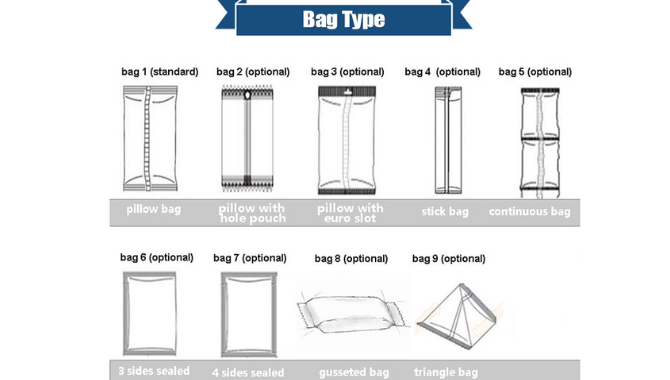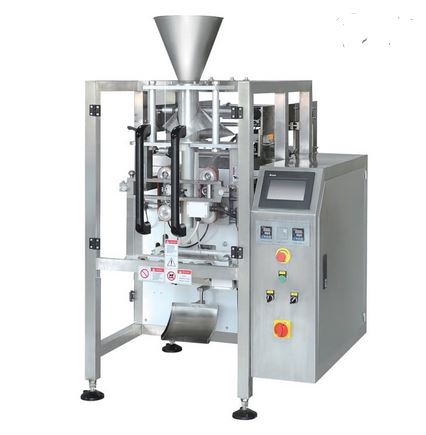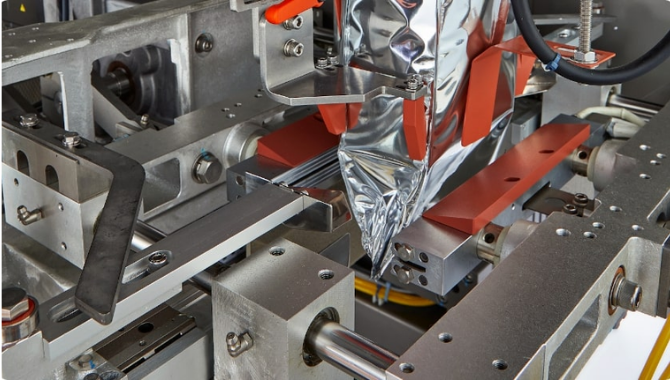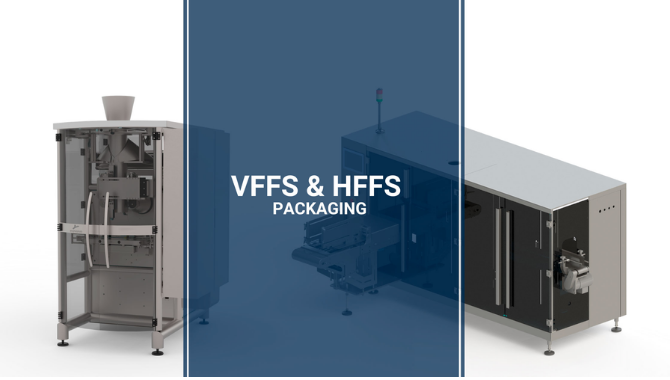This is the shape a common bag will end up in, the VFFS bag has three seams as shown above.

1. What is the best use for vertical bagging?
VFFS is a flexible, fast method of getting loose, dry products into air-tight, portion-controlled packaging. These are called free-flow products. Depending on the bag and laminate material, VFFS can hold your food or product. VFFS can be used to make small bags that come in large packages, such as a small bag of salt in a bag of potato chips.
This type of packaging can also incorporate something called a gas flush, which helps preserve your raw materials for longer.
2. What is an air rush?
Also known as Modified Atmosphere Packaging (MAP) gas flushing involves repeated injection and removal of inert gas into the package to eliminate oxygen.
An inert gas such as carbon dioxide or nitrogen is denser than oxygen, so it squeezes the oxygen out of the package. The benefits of gas flushing are:
- Extend product shelf life
- Improve product integrity
- Prevents discolouration
- A cushion-like cushion can be provided to prevent damage (think potato chip packets for example – the air inside comes from the gas flushing process)
In some cases, depending on the type of product, oxygen may remain in the packaging.
E.g;
- In red meat, oxygen helps maintain the fresh, natural color
- In fruits and vegetables, oxygen helps maintain respiration
- In fish and certain types of vegetables, oxygen inhibits the growth of aerobic organisms
3. What raw materials can be used for vertical fill seals?
Anything loose, granular and relatively dry. Like powders, abrasives, spices, candies, seeds, sand beads, mixtures or ingredients and similar products.
VFFS can be used for food and non-food.
Raw materials are usually received in 15kg – 20kg bags, barrels, barrels or similar. If you have a large shipment, please contact us and we can handle shipments of any size. Currently, WePack does not use VFFS to package liquids.
4. What size and shape bags can be produced?
Any square or rectangular bag can be made on the VFFS machine.
width:
- 65mm
- 100mm
- 140mmm
length:
- Length up to 150mm
Color and print available:
- Plain white
- Ordinary silver
- Simple and clear
The vertical form fill seal creates a pillow bag shape that looks like this:

5. How to use the VFFS control section?
A target weight can be set for each bag, which means you can achieve consistency across all products, achieving a “minimum fill” so no bag is too light.
6. How is the bag sealed?
The bag is sealed using heat and pressure to create a crimp seal. Seals can vary based on how flat they are or how pronounced they are. A good vertical form seal is all about minimizing the length of the seal, so unnecessary material is not used, so the final bag is easy to pack together in larger outer packaging for transport.
7. What material can this bag be made of?
There are many different materials that can be used to make this bag. Typically polyethylene terephthalate (PET) or polyethylene (PE) films are used as a common plastic. It’s a strong, sturdy material with good sealing properties and will keep many products fresh for a reasonable amount of time.
The laminate helps protect your product Laminates are used as an extra layer to protect the raw materials. For example, laminated foils are often used in combination with PE or PET to protect taste or prevent odors from escaping from the film.
Laminate is generally used:
- Keep product flavours and aromas fresh
- Protection of products from external fragrances
Foils and variable gauges for PE, PET, polyester laminates are often used to control these challenges. Some raw materials can damage laminates, so it is important to understand the chemical composition of the product and choose the right laminate.
The different laminates are tailored to the specific needs of the interior product and there are many varieties to choose from. Water-soluble membranes—one that dissolve completely when placed in water—are also available.
Your contract packaging company should be able to advise you on the correct laminate based on your raw materials.
8. How does VFFS actually work?
- The machine is prepared by loading a suitable roll of film
- The film is wound on a series of rollers to form a tubular
- The tube is closed with a clip at the bottom to create the bottom of the bag
- Raw materials are put into semi-formed bags
- The top of the bag is sealed
- The seal forms the bottom of the next bag
- Bottom seal cut in the middle from the next bag

The process happens quickly – around 30-40 bags per minute can be produced, working with 65mm x 65mm bags and granular products.
9. HFFS vs VFFS Machine
There are two types of FFS machines: horizontal and vertical (HFFS and VFFS, respectively). The main difference between the two is how the machine distributes the content to the flexible packaging. Due to their different constructions, HFFS packing machines and VFFS packing machines are tailored to specific product types – see which machine will work best with your product.
- HFFS: Best for solid, single-piece products that are easy to carry and handle, such as candy bars, small toys, soap bars, etc.
- VFFS: Vertical Fill is best for loose, granular, pasty or products that are difficult to handle manually. VFFS machines are suitable for sugar, salt, liquid, chips, cream, oil and gel.
As you can see, the type of product you have will determine what type of machine you need. If you have multiple product lines from solid to semi-solid, you will need both machine types, and if you don’t have the capability, resources or space to have both, it will be difficult to accommodate both. Working with a foundry can solve these problems for small manufacturers.

11. How to choose the right VFFS machine?
After you have determined the type of machine you need, you will next need to search for manufacturers who can provide further expertise. There are various HFFS and VFFS machines on the market with different design capabilities to suit different manufacturing environments. Each manufacturer offers its own style of technology, and even seemingly similar machines from different manufacturers can vary widely in price. Use the 10 tips below to help guide the buying process for success.
Here are 10 tips to choose the right VFFS machines:
Tip 1: Align machine design with maximum volume packaging
Many first-time purchases of vertical form fill seal machines are large enough to pack all of their bags from the widest to the narrowest. On the surface, this makes sense – buy a machine and automate the entire operation. The problem with this method is that wider bags, larger form fill sealers and more expensive. Also, larger machines tend to handle wider bags well but not fill narrower ones well.
A more efficient strategy for buying your first machine is to size the machine to the width of the largest capacity bag—the size that requires automation the most. The machine will optimize the bread and butter pack size, will run the fastest, use the least amount of material, and be the most economical operation. Perhaps the semi-automatic operation for other sized bags could be continued, or a second machine could be considered in the future. Don’t designate a machine as a do-it-all because it ends up being a master of nothing. This vertical form fills seal machine simply won’t live up to expectations and will be a potential headache for years.
Tip 2: Work with an OEM who understands the application
Building a machine that can run for years without problems is as much an art as a science. Work with manufacturers who have a proven track record in product and film type. Manufacturers know how to be successful in their applications.
Tip 3: Accept Packaging Suggestions
Some customers come to the OEM saying we want to run the same package. Matrix advises clients to remain open to alternatives. On high-speed automated machines, a slightly different width, length or film type may run much more efficiently than the original. This does not mean that originals are always discarded. It is not. Just be willing to discuss these options. Also, expect the manufacturer to provide sample bags. Work with the manufacturer to make necessary improvements.
Tip 4: The manufacturer should be able to recommend some film suppliers
Studios are experts in movies. They invest in the latest manufacturing technology to reduce costs and improve performance. Machine OEMs should have experience working with the best film manufacturers and recommend the most suitable applications to their customers. Do not buy the film from a formed film sealing OEM as it is only a revenue generator and not in the best interest of the customer.
Tip 5: OEMs should offer flexible filling machines
The filling machine is special equipment for synchronously measuring the products into the forming-filling-sealing machine after the collection project. Fillers are optimized for the type of product being packaged. Just as film companies are experts at what they do, infill companies are experts at different designs for different products. During the life of a form-fill-seal machine, two, three, four or more fillers may adhere to the machine due to variations in product mix.
A choice of form fill seal manufacturers will have the software already installed on their machines that will synchronize the various fills. The software on the form-fill-sealer syncs to the new fill over time and as the fill changes. This will result in optimal installation time and higher uptime for the machine. For example, in its standard software package, Matrix has 8 different control methods to synchronize the filling. With this software strategy, changing fillers is seamless. Partnering with an outside film supplier and having the flexibility to replace filler ensures that equipment purchased today will grow with the company’s future needs.
Tip 6: No Tool Switching and Other Key Operational Strategies
Being able to efficiently run multiple bag sizes on one machine – similar widths and different lengths – gives organizations more flexibility. A quick way to “switch” the machine between different bag sizes is to let the operator switch between different sizes of filling tubes without the need for wrenches, screwdrivers and other tools. This is called a tool-less changeover, and it’s a must for organizations because it’s fast, efficient, and doesn’t require removing maintenance personnel from more urgent tasks to replace parts.
The new bag size meant that a new roll of film would need to be strung on the machine. The form-fill-seal OEM should demonstrate the new role of stringing. If the process is time-consuming and cumbersome for the OEM, it is also for the operator, losing a lot of time in the transition process. Go for speed and simplicity.
Another thing to note is the operator interface. The interface should be intuitive and multilingual to accommodate a range of operators. The on-screen help function should actually be able to help without requiring a software engineering degree to navigate.
Tip 7: Watch out for 360-degree timing
In past generations, the canonical form-fill-seal machine has timed 360 degrees. As the film is pulled down, formed, filled, and sealed, the timing cam makes a full turn—360 degrees. The temperature, time and pressure of the sealing process are all set for this revolution. For example, a 360-degree machine can be calibrated at the factory to run 30 bags per minute — 30 360-degree rotations per minute. When the machine is installed, in this example it is set to run at 30 bags per minute. But what happens if a customer needs to speed up or slow down production for various reasons? All the timing cams on the machine have to be re-adjusted, a time-consuming and frustrating task to perform and get right of.
The latest generation of machines does not use 360-degree timing. Speeding up or slowing down these machines does not affect optimal sealing times and temperatures. Ask the OEM if they use 360-degree timing. If the answer is yes, look for more modern control and timing strategy.
Tip 8: The base price should include stainless steel construction, registration capabilities, and automatic web guide control
Some OEMs keep floor prices low by ignoring basic features. Without these features, this machine wouldn’t be cheap. Determine if the base price of the machine includes stainless steel construction, registration capabilities, and automatic guide net controls.
Stainless steel is essential for extended service life and food safety
Print Registration Assurance Pack and Copy Lineup
Automatic reel guide control ensures correct sealing, optimum productivity and low waste
If the base price does not include these features, ask the OEM to provide the price for a machine with these features. Because like all other features described in this white paper, they are required for the best machine experience.
Tip 9: Ask the manufacturer for the average annual operating costs
Many parts on a machine, such as knives, heaters, and strips, are considered consumables because they need to be replaced regularly. Other parts, like knife cylinders that work in warm temperatures, need to be replaced more frequently than others, but not as often as consumables. The cost of ongoing consumables and replacement parts should be considered in purchasing decisions. The OEM should have this information.
Tip 10: Keep it simple
Complexity and reliability are often contradictory. Ask about the OEM’s design strategy. Did the simple word appear? Open the control cabinet. Compare the differences in part appearance and quantity from different suppliers. Is one clean and streamlined and the other crowded?
It’s also a good idea to visit a manufacturing facility. Ask design engineers about their basic design philosophy. Observe how common tasks such as transformations are performed on the machine. If this is difficult for the manufacturer, it will not be easier for the operator of the machine. Communicate with OEM customers. Ask these customers about their buying experience.
Every application is unique. But they also have something in common. Use these 10 tips to help guide your buying decision successfully.


